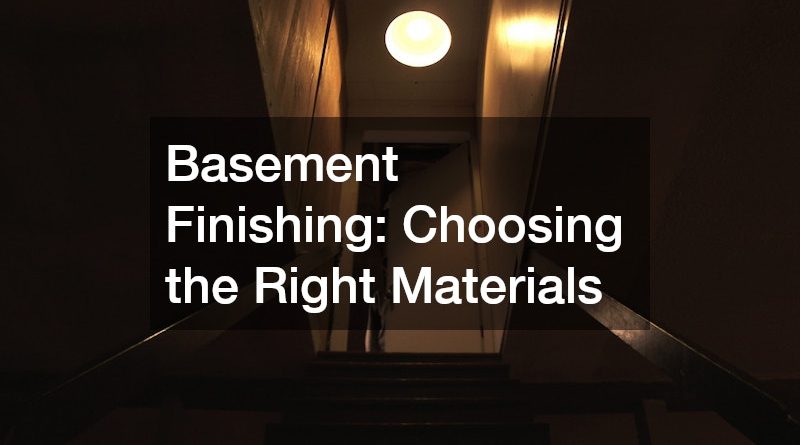Basement Finishing Choosing the Right Materials
Discover how to transform your basement into a functional and aesthetically pleasing living space by choosing the right materials. Learn about important considerations and popular choices for finishing your basement.
What Are the Best Flooring Options for Basements?
Pros and Cons of Common Basement Flooring Materials
When selecting flooring for a basement, it’s important to weigh both the pros and cons of available materials. Carpet, for instance, can add warmth but may be prone to mold in damp environments.
Vinyl offers a moisture-resistant option with various designs, but might not provide the same level of insulation as other materials. Tile is durable and easy to clean, though often cold and hard on the feet, which can be a drawback for comfort.
Considering your specific needs and basement conditions will help you determine the most suitable flooring. Many homeowners prefer a combination of materials for a balanced approach that addresses different uses within the space.
Choosing Moisture-Resistant Flooring
Moisture-resistant flooring is crucial in basements to prevent long-term damage and maintain a healthy environment. Vinyl stands out as a popular choice due to its water-resistant properties and low maintenance.
Concrete stained or sealed also provides excellent moisture resistance while allowing for creative aesthetic choices. Engineered wood can be an alternative that offers a natural look with improved resistance to moisture compared to traditional hardwood.
Assessing the level of humidity and potential water exposure in your basement will guide your decision towards the most appropriate moisture-resistant flooring. A vapor barrier beneath the selected material can further enhance its performance in humid conditions.
What Wall Finishes Should Be Considered for Basements?
Understanding Different Wall Material Types
Choosing the right wall finish is vital for ensuring a basement is both durable and visually appealing. Drywall provides a smooth and customizable surface, making it a popular choice for many basements.
Paneling adds texture and can hide imperfections or minor structural issues, though it might not suit all design tastes. Paint, when used on proper substrates, can offer endless color options and seal surfaces against minor moisture exposure.
Opting for moisture-resistant primers or treatments when applying paint is essential to prevent damage over time. Combining these wall materials can result in a versatile and aesthetically pleasing basement environment.
Moisture Protection and Insulation for Basement Walls
Proper moisture protection and insulation are paramount to maintaining a comfortable basement atmosphere. Insulating the walls with moisture-resistant materials helps maintain a steady temperature and reduces the growth of mold and mildew.
Materials like foam board insulation offer effective moisture resistance and add an extra layer of thermal protection. Additionally, implementing waterproof barriers or membranes behind wall finishes can enhance moisture control.
Selecting the right combination of insulation and moisture protection measures is essential for long-term basement sustainability. This approach ensures a space that is both cozy and durable, suitable for various activities.
Which Ceilings Work Best in Basements?
Popular Basement Ceiling Styles
The ceiling choice can significantly impact the overall look and functionality of a basement. Suspended ceilings are popular due to their ability to hide utilities while offering access when needed.
Drywall ceilings provide a seamless and polished appearance, though they can be more challenging to access for repairs. Some homeowners prefer exposed ceilings, which add an industrial look and maximize height.
Balancing aesthetics and practicality is key when selecting a ceiling style that suits your basement’s layout. Considering acoustics and lighting integration can further influence your final decision.
Addressing Height and Accessibility Concerns
Choosing materials that accommodate ceiling height restrictions is crucial in basement design. Low ceilings can often benefit from lighter colors and materials that maximize the perception of space.
Accessibility is another vital factor when it comes to ceiling installations, ensuring easy reach for plumbing and ductwork. Suspended ceilings offer plates that can be easily removed for maintenance, catering to these needs efficiently.
Evaluating everyday accessibility and future modification plans will guide the material selection process. This consideration allows for efficient problem-solving should issues arise in concealed areas of your basement.
How to Choose the Right Lighting for a Finished Basement?
Types of Lighting to Consider
Effective lighting transforms a basement’s atmosphere into an inviting and functional space. Recessed lighting offers a sleek and unobtrusive option that fits well with low ceilings.
Track lighting ensures flexibility, allowing light to be adjusted to suit various focal points or tasks within the room. Floor lamps and table lamps provide ambient lighting and further enhance specific zones or activities.
Choosing a mix of these lighting types contributes to a cohesive and versatile lighting strategy. This approach ensures varied illumination levels that adapt to both everyday use and social gatherings.
Energy Efficiency and Brightness Considerations
Energy-efficient lighting not only reduces your carbon footprint but also saves on long-term energy costs. LED lights are an excellent choice, providing bright illumination with minimal energy consumption.
In basements, it’s crucial to strike a balance between brightness and comfort, ensuring adequate visibility without overwhelming starkness. Using dimmers with your lighting fixtures can allow customization to suit different activities and moods.
Evaluating both the aesthetic and functional needs of your basement will aid in choosing the most appropriate lighting solutions. Energy efficiency should remain a priority, with considerations for eco-friendly options and future upgrades.
Choosing the right materials for your basement finishing project is crucial in achieving a space that is both functional and stylish. By understanding which materials work best for flooring, walls, ceilings, and lighting, you can create a basement that meets your needs and enhances your home.

